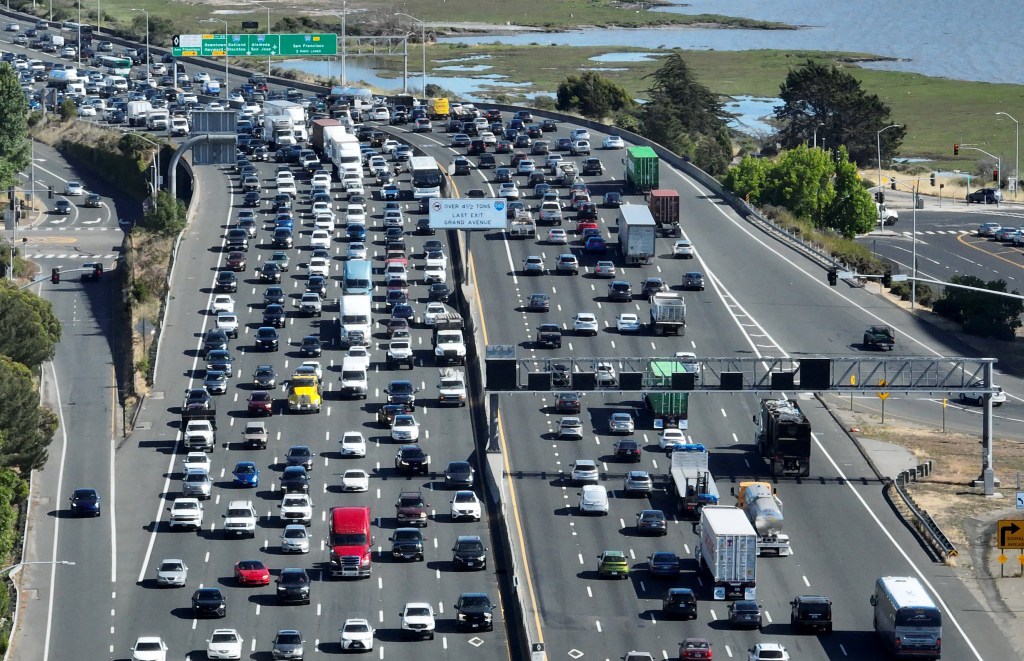Headed out of town for the Fourth of July? Expect long delays on the roads and at the airport security lines during what is expected to be a record-breaking holiday travel week.
Independence Day arrives just as a week-long heat wave has begun scorching California, prompting warnings for drivers to prepare for 90-plus degree temperatures on their way to the coast, the mountains or just about anywhere else in the state.
Bay Area CHP Officer Andrew Barclay said holiday traffic has already ramped up across the region. He anticipates the roadways to become even more crowded as the long weekend gets underway.
“Anybody who ventures out in the next few days needs to plan for extended drive times,” Barclay said. “Please practice patience and understand there’s going to be traffic.”
By Tuesday afternoon, traffic was already backing up on Interstate 80 toward Tahoe, eastbound 580 over the Altamont Pass and Highway 1 through Santa Cruz, according to Caltrans’ live traffic map.
Nationwide, AAA projects that a record 60.6 million people will travel by car during the Fourth of July week. That’s a 5% increase from 2023 and a 9.5% jump from 2019.
“With summer vacations in full swing and the flexibility of remote work, more Americans are taking extended trips around Independence Day,” Paula Twidale, senior vice president of AAA Travel, said in a statement. “We anticipate this July 4th week will be the busiest.”
Bay Area travelers should also expect to pay at the pump.
Gas prices averaged $4.81 for a gallon of regular in San Jose on Tuesday, up from $4.77 last year but down from $5.14 a month ago, according to AAA. In Oakland, prices hit $4.86, slightly more than $4.84 last year.
Statewide, prices averaged $4.79 a gallon, down from $4.84 a year ago.
“Here is more expensive than Nevada,” said San Francisco resident Joao Prebilli, who’s planning to drive through that state with his mom and girlfriend on their way to visit Arizona’s national parks this weekend.
“We’re going to leave early, around six in the morning,” he said, to try to beat the traffic.
The worst time to hit the road? Between 2 p.m. and 7 p.m. on Wednesday, according to INRIX, a transportation data analytics company. Sunday afternoon and evening will also be a slog as travelers return home.
“Road trips over the holiday week could take up to 67% longer than normal,” Bob Pishue, transportation analyst at INRIX, said in a statement. “Travelers should monitor 511 services, local news stations and traffic apps for up-to-the-minute road conditions.”
Barclay with the CHP encouraged drivers to prepare for the heat by packing plenty of water and topping vehicles off with coolant. Caltrans, the state transportation agency, also recommends checking air conditioning systems, cabin filters, tire pressure and oil levels.
Anyone driving an electric vehicle should be mindful of their batteries. A recent study from EV battery data company Recurrent found that EVs can lose up to 30% of their total range when temperatures reach above 95 degrees.
“Make sure your vehicle has everything that it needs not only to run but sit in traffic and be idle,” said Barclay. The CHP plans to have additional officers on highways to help stranded drivers.
The National Weather Service has issued an excessive heat warning for much of the state, cautioning that temperatures could reach as high as 110 degrees in some inland areas. Officials said there’s a serious risk of heat-related illnesses and reminded travelers not to leave people or pets in vehicles.
“It’s going to be potentially a deadly heat wave that we’re seeing right now,” said weather service meteorologist Nicole Sarment.
At the airports, the Transportation Security Administration expects to screen more than 32 million people from Thursday, June 27, through Monday, July 8, a 5.4% increase over 2023. On Sunday, June 23, the TSA broke the record for the most people screened on a single day, at nearly 3 million.
“We expect this summer to be our busiest ever and summer travel usually peaks over the Independence Day holiday,” TSA Administrator David Pekoske said in a statement.
The San Francisco International Airport forecasts that about 156,500 people will arrive and depart on July 3. That would still be below the summer’s travel peak of 167,180 people on June 13.
“We recommend travelers still allow extra time and get to the airport two hours prior to a domestic flight, three hours for international,” said airport spokesperson Doug Yakel.
Meanwhile, the San Francisco Bay Oakland International Airport projects over 170,000 passengers to pass through between Wednesday, July 3, and Sunday, July 7, similar to last year’s levels, with Wednesday and Sunday being the peak travel days, according to airport spokesperson Kaley Skantz.
Between Thursday, June 27, and Friday, July 5, San Jose Mineta International expects to see up to 350,252 passengers. June 27 and 28 were forecast to be the peak travel days.
With this week’s heat wave also expected to extend across much of the country and storms forecast throughout the Midwest and East Coast, flight delays and cancellations threaten to upend holiday plans.
Even so, Pekoske with the TSA said airport officials are prepared for the expected crush of travelers.
“We are ready, along with our airline and airport partners, to handle this boost in passenger volumes,” he said.
